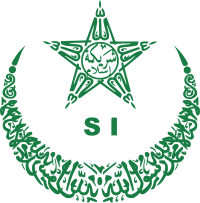 Logo of Sarekat Islam | |
| Abbreviation | SI |
|---|---|
| Formation | 1911 (as Sarekat Dagang Islam, SDI) 1912 (renamed to Sarekat Islam, SI) |
| Type | Political organization |
| Headquarters | Surabaya |
Membership | 350,000 (1916) |
Official language | Indonesian |
| Leader | Samanhudi (1911–1912) Oemar Said Tjokroaminoto (1912–1934) Abikusno Tjokrosujoso (1934–1940) |
Sarekat Islam or Syarikat Islam (lit. 'Islamic Association'[1] or 'Islamic Union';[2] SI) was an Indonesian socio-political organization founded at the beginning of the 20th century during the Dutch colonial era. Initially, SI served as a cooperative of Muslim Javanese batik traders to compete with the Chinese-Indonesian big traders. From there, SI rapidly evolved into a nationalist political organization that demanded self-governance against the Dutch colonial regime and gained wide popular support. SI was especially active during the 1910s and the early 1920s. By 1916, it claimed 80 branches with a total membership of around 350,000.[3]
SI was eventually embroiled in an internal conflict between the Islamic moderates and the radical communist members who urged firmer anti-colonialist and anti-capitalist actions. In 1921, the organization was split and communist members founded a separate entity known as the Sarekat Islam Merah (Red Islamic Association) which was absorbed into the Communist Party of Indonesia (PKI). The split led to the decline of the organization, and the original SI later turned into a political party, Indonesian Islamic Union Party (PSII).[4] PSII was fused into the United Development Party (PPP) in 1973.
Today, SI is credited as the first large-scale Indonesian nationalist organization (or mass organization, ormas) and the largest Muslim political organization in the pre-independence era.[3][5][6]
- ^ Makin 2016, p. 249.
- ^ Ricklefs 2008, p. 18.
- ^ a b Sarekat Islām. Encyclopædia Britannica. Retrieved January 27, 2021.
- ^ Formichi, Chiara (2012). Islam and the Making of the Nation: Kartosuwiryo and Political Islam in 20th Century Indonesia (PDF). Brill Publishers. ISBN 978-90-04-26046-7.
- ^ Ooi 2004, p. 1180.
- ^ Cite error: The named reference
Oxwas invoked but never defined (see the help page).